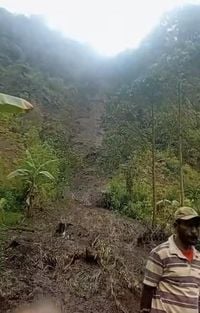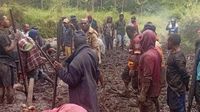In the early hours of October 31, 2025, tragedy struck the remote village of Kukas in Papua New Guinea’s Enga Province, as a sudden landslide swept through the community, claiming at least 21 lives and leaving several more missing. The disaster, triggered by heavy rainfall, occurred between 2:00 and 3:00 a.m. while most villagers were asleep, offering little chance for escape. As the sun rose over the Minamb Valley, the true scale of the devastation began to emerge, with villagers and emergency crews scrambling to recover bodies and search for survivors amid the debris.
According to reports from the National Broadcasting Corporation of Papua New Guinea, the landslide struck Kukas, a small and isolated settlement nestled in the Wapenamanda District. The area, characterized by steep slopes and rugged terrain, has long been vulnerable to such natural disasters. The initial death toll varied slightly across sources: police and government officials confirmed 21 fatalities, while some local leaders and residents feared the number could reach 30 as rescue efforts continued. "We currently don't know the total number of people killed in this landslide, and the figure may still go up after we do a head count of everyone," Lasro Mola Panga, chairman of the Minamb Valley Peace and Security Foundation, told local media.
Heavy rainfall in the days leading up to the incident is believed to have saturated the hillside above Kukas, destabilizing the regolith and causing a slope failure. Satellite images and eyewitness accounts suggest the landslide originated high on the slope in a natural gully, stripping the mid-slope area down to bedrock before crashing into the village below. At least one large house near a creek at the foot of the mountain was completely buried, with reports indicating that as many as three houses may have been in the direct path of the slide.
The timing of the disaster proved particularly deadly. As described by Mr. Tumu, a deputy principal at a nearby school, the victims were mostly visitors from a neighboring village about five kilometers away. These guests had traveled to Kukas to participate in local government elections but decided to stay overnight due to unrest and violence in their own community. "They decided to go to a relative’s house, and that is where they encountered this fate — this tragedy," Tumu explained to ABC News. The combination of early morning darkness and the suddenness of the event left the sleeping occupants with virtually no chance to escape.
The aftermath has been harrowing for survivors and rescuers alike. Ben McPitu, a local resident who shared video footage and images of the scene on social media, described the pain and loss as "beyond words," noting, "Our community is in mourning." As villagers dug through the mud and debris with their hands and rudimentary tools, the overwhelming sense of loss was palpable. Recovery operations were further hampered by the remoteness of Kukas and the poor quality of baseline mapping in rural Papua New Guinea, making it difficult for outside aid to pinpoint the exact location and scale of the disaster.
Local government disaster teams responded swiftly, dispatching personnel and supplies to assist with the recovery. Acting Provincial Commander-in-Chief Inspector Kelly Sombe confirmed that three people had sustained serious injuries and were admitted to Wabag Hospital for treatment. The ongoing search for missing persons has been complicated by the challenging terrain and the threat of additional landslides, as heavy rains continued to batter the region in the days following the disaster.
The events in Kukas are tragically reminiscent of another catastrophic landslide that struck Enga Province just months earlier, in May 2024. That disaster, which occurred in the Mulitaka area, claimed at least 670 lives according to United Nations estimates, with the Papua New Guinea government suggesting that more than 2,000 people may have been buried. These repeated calamities highlight the acute vulnerability of Papua New Guinea’s mountainous regions to landslides, a risk exacerbated by deforestation, population pressures, and the increasing intensity of rainfall linked to climate change.
Enga Governor Peter Ipatas, speaking to Australian Broadcasting Corp., acknowledged the scale of the tragedy and the difficulties faced by local authorities. He noted that while police maintained the official death toll at 21, some community members reported as many as 30 fatalities. The lack of reliable infrastructure and communications in rural Papua New Guinea further complicates both the immediate response and the long-term recovery for affected villages.
For the residents of Kukas and their neighbors, the landslide has brought not only grief but also renewed calls for greater disaster preparedness and investment in early warning systems. Despite their resilience and rapid mobilization in the face of crisis, local communities remain largely dependent on their own resources in the critical hours after such events. "Villagers are working to recover bodies after the landslide," reported ABC News, capturing the somber determination of those left behind to find closure and support one another through the ordeal.
The tragedy has also drawn attention to the broader challenges facing Papua New Guinea, a nation where rugged landscapes, frequent seismic activity, and extreme weather events combine to create a perilous environment for many rural communities. As Mate Bagossy, U.N. humanitarian adviser for Papua New Guinea, and other international observers have noted, addressing these risks requires not only emergency response but also long-term strategies to strengthen infrastructure, improve land management, and support vulnerable populations.
As recovery operations continue in Kukas, the full extent of the loss remains uncertain. With dozens of families mourning loved ones and searching for the missing, the scars of this disaster will linger long after the last body is recovered. Yet amid the devastation, the courage and solidarity of the villagers stand as a testament to the enduring spirit of Papua New Guinea’s highlands. For now, the focus remains on supporting survivors, honoring the dead, and learning from the tragedy in hopes of preventing such heartbreak in the future.


